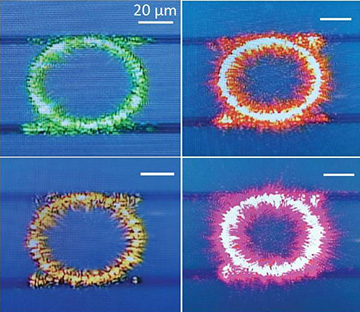
A series of nanophotonic resonators, each slightly different in geometry, generates different colors of visible light from the same near-infrared pump laser. [Image: NIST]
The ability to generate visible laser light in a variety of colors in a miniature device could lead to advances in spectroscopy, metrology, and quantum science. One approach to doing so—nonlinear optical processes that generate visible light from a near-infrared (near-IR) source—can perform well, but generally requires large tabletop systems that consume a lot of power.
Now, a team at the U.S. National Institute of Standards & Technology (NIST) and University of Maryland, USA, report a micro-resonator that the researchers say can transform near-IR light from a compact laser source into visible light at any one of a variety of colors including red, yellow, orange, and green (Optica, doi: 10.1364/OPTICA.393810 ).
Material success
Key to the team’s success, says study co-author and OSA Fellow Kartik Srinivasan of NIST, was fabricating the micro-resonator in silicon nitride, a material with good nonlinear optical properties. With dozens of ring-shaped micro-resonators etched onto each chip, he says, the team was able to exploit those nonlinear material properties to realize the process known as optical parametric oscillation (OPO).
In traditional OPO, according to Srinivasan, the nonlinear material converts pump laser light into two different output frequencies to create different colors of light—albeit typically in large, tabletop setups. Working from that concept, however, Srinivasan, with co-author Xiyuan Lu and colleagues, were able to miniaturize the process so that it could be realized on a microchip that is pumped by a commercially available near-IR laser source.
In their setup, they send light into the micro-resonators, where it circulates thousands of times before being output at different frequencies. By varying the dimensions of the micro-resonator rings, the researchers were able to tune the near-IR (780–790 nm) output of the pump laser to achieve colors in the visible spectrum ranging from 560 nm to 760 nm, as well as infrared wavelengths ranging from 800 nm to 1200 nm.
Foundry ready
“Silicon nitride is important to the success of this device, though its key features are achievable with other materials as well,” Srinivasan says. And, he adds, “the device geometry is compatible with foundry fabrication at the wafer-scale, meaning that you could literally print hundreds of thousands of devices on a wafer using processes that are standard to that facility.”
In such a scenario, Srinivasan says, “the cost of a chip containing many of these resonators could be relatively small, say less than $100.”
Other key requirements for the team’s setup, according to Srinivasan, are broadband optical transparency, so that the material supports low losses at the output wavelengths; a reasonably strong Kerr nonlinearity, or third-order nonlinearity; the ability to strongly modify wavelength dispersion by varying the device dimensions; and the ability to be deposited in thin films suitable for planar fabrication techniques.
But challenges remain for coming up with a practical working device, Srinivasan notes. The team is now particularly focused on pushing wavelength coverage deeper into the visible region—into the blue and violet—as well as on improving the device’s output power. Both will likely require design changes and trade-offs to reach the desired results, according to Srinivasan. Likely the most difficult challenge, he adds, will be achieving broad wavelength tunability within a single device.
A place in optical clocks
A working micro-resonator device of the type his team envisions holds much promise, in the view of Srinivasan, who cites optical atomic clocks as one application example. “Optical atomic clocks are the most accurate and precise timekeeping devices known,” Srinivasan says. They could, for example, greatly reduce how often some clocks must be re-synchronized with respect to GPS signals, which can be hard to acquire in some environments, he says.
For now, these clocks are mostly laboratory instruments. But Srinivasan points out that significant efforts are afoot to reduce the size and power requirements of atomic clocks to make the portable and useful outside of the lab—even in vehicles or satellites. Indeed, the team’s work is part of the “NIST On a Chip” program which seeks to bring the government agency’s measurement science directly into the hands of users. “Our technology could contribute to such efforts, as one important element in an optical clock is a laser, and in many cases that laser needs to operate at visible wavelengths,” says Srinivasan.
The quantum-technology realm is also potentially intriguing, according to Srinivasan. For quantum networks, he explains, researchers are developing different types of quantum technologies, based on quantum dots, color centers in crystals, trapped ions/atoms, and so on, that are good at doing things like generating or storing quantum states of light. “In general, such systems are coherently controlled by lasers, and in many cases, the lasers needed must work in the visible or near-infrared,” Srinivasan says. “Our [miniaturized] technology might be an attractive alternative to the benchtop lasers that are typically used.”
